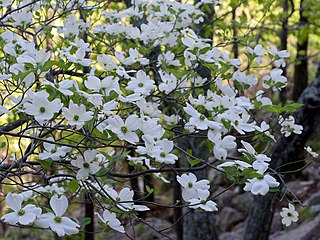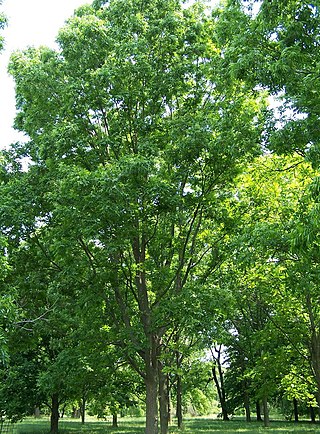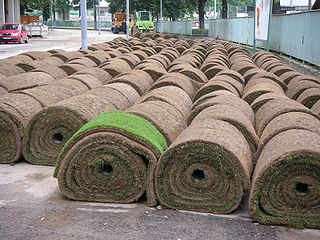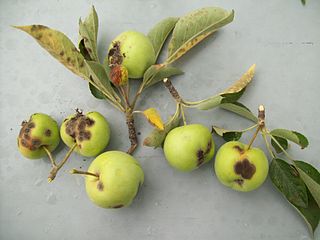Related Research Articles

Cornus florida, the flowering dogwood, is a species of flowering tree in the family Cornaceae native to eastern North America and northern Mexico. An endemic population once spanned from southernmost coastal Maine south to northern Florida and west to the Mississippi River. The tree is commonly planted as an ornamental in residential and public areas because of its showy bracts and interesting bark structure.

The pecan is a species of hickory native to the southern United States and northern Mexico in the region of the Mississippi River.

Fire blight, also written fireblight, is a contagious disease affecting apples, pears, and some other members of the family Rosaceae. It is a serious concern to apple and pear producers. Under optimal conditions, it can destroy an entire orchard in a single growing season.

Pollination of fruit trees is required to produce seeds with surrounding fruit. It is the process of moving pollen from the anther to the stigma, either in the same flower or in another flower. Some tree species, including many fruit trees, do not produce fruit from self-pollination, so pollinizer trees are planted in orchards.

Pollination management is the horticultural practices that accomplish or enhance pollination of a crop, to improve yield or quality, by understanding of the particular crop's pollination needs, and by knowledgeable management of pollenizers, pollinators, and pollination conditions.

Citrus production encompasses the production of citrus fruit, which are the highest-value fruit crop in terms of international trade. There are two main markets for citrus fruit:

Sod, also known as turf, is the upper layer of soil with the grass growing on it that is often harvested into rolls.

Apple scab is a common disease of plants in the rose family (Rosaceae) that is caused by the ascomycete fungus Venturia inaequalis. While this disease affects several plant genera, including Sorbus, Cotoneaster, and Pyrus, it is most commonly associated with the infection of Malus trees, including species of flowering crabapple, as well as cultivated apple. The first symptoms of this disease are found in the foliage, blossoms, and developing fruits of affected trees, which develop dark, irregularly-shaped lesions upon infection. Although apple scab rarely kills its host, infection typically leads to fruit deformation and premature leaf and fruit drop, which enhance the susceptibility of the host plant to abiotic stress and secondary infection. The reduction of fruit quality and yield may result in crop losses of up to 70%, posing a significant threat to the profitability of apple producers. To reduce scab-related yield losses, growers often combine preventive practices, including sanitation and resistance breeding, with reactive measures, such as targeted fungicide or biocontrol treatments, to prevent the incidence and spread of apple scab in their crops.

Carya ovata, the shagbark hickory, is a common hickory in the Eastern United States and southeast Canada. It is a large, deciduous tree, growing well over 100 ft (30 m) tall, and can live more than 350 years. The tallest measured shagbark, located in Savage Gulf, Tennessee, is over 150 ft (46 m) tall. Mature shagbarks are easy to recognize because, as their name implies, they have shaggy bark. This characteristic is, however, only found on mature trees; young specimens have smooth bark.

Santalum acuminatum, the desert quandong, is a hemiparasitic plant in the sandalwood family, Santalaceae, which is widely dispersed throughout the central deserts and southern areas of Australia. The species, especially its edible fruit, is also commonly referred to as quandong or native peach. The use of the fruit as an exotic flavouring, one of the best known bush tucker, has led to the attempted domestication of the species.
A rootstock is part of a plant, often an underground part, from which new above-ground growth can be produced. It could also be described as a stem with a well developed root system, to which a bud from another plant is grafted. It can refer to a rhizome or underground stem. In grafting, it refers to a plant, sometimes just a stump, which already has an established, healthy root system, onto which a cutting or a bud from another plant is grafted. In some cases, such as vines of grapes and other berries, cuttings may be used for rootstocks, the roots being established in nursery conditions before planting them out. The plant part grafted onto the rootstock is usually called the scion. The scion is the plant that has the properties that propagator desires above ground, including the photosynthetic activity and the fruit or decorative properties. The rootstock is selected for its interaction with the soil, providing the roots and the stem to support the new plant, obtaining the necessary soil water and minerals, and resisting the relevant pests and diseases. After a few weeks, the tissues of the two parts will have grown together, eventually forming a single plant. After some years, it may be difficult to detect the site of the graft although the product always contains the components of two genetically different plants.

Malus floribunda, common name Japanese flowering crabapple, Japanese crab, purple chokeberry, or showy crabapple, originates from Japan and East Asia. It may be a hybrid of M. toringo with M. baccata, in which case it would be written as Malus × floribunda.
Sphaceloma perseae is a plant-pathogenic fungus in the division Ascomycota. It infects the avocado plant, a tree native to Central America and Mexico. Currently there are three cultivars of avocados in large-scale agricultural production: Guatemalan, Mexican, and West Indian. The pathogen is currently limited to the P. Americana species but is able to infect all three cultivars. The resulting disease is known as avocado scab for the symptoms which are present on the fruit of the avocado tree. It is believed that the disease developed in Florida in the early twentieth century and is related to citrus scab, Elsinoe fawcetti. Since then, S.perseae has spread to many regions worldwide that support cultivation of the avocado tree. This pathogen threatens the global avocado market, including both importers and exporters of the crop. Countries which import avocados, including the United States, have experienced a rising demand over the past decade which is projected to continue for years to come. An understanding of avocado scab characteristics and feasible prevention methods is essential to maintenance of cultures and economies influenced by the avocado fruit.

Carya tomentosa, commonly known as mockernut hickory, mockernut, white hickory, whiteheart hickory, hognut, bullnut, is a species of tree in the walnut family Juglandaceae. The most abundant of the hickories, and common in the eastern half of the United States, it is long lived, sometimes reaching the age of 500 years. A straight-growing hickory, a high percentage of its wood is used for products where strength, hardness, and flexibility are needed. The wood makes excellent fuel wood, as well. The leaves turn yellow in Autumn.
This article summarizes different crops, what common fungal problems they have, and how fungicide should be used in order to mitigate damage and crop loss. This page also covers how specific fungal infections affect crops present in the United States.
Pecan anthracnose is a fungal disease of pecan trees caused by the ascomycete Glomerella cingulata (Stoneman) Spauld. & H. It is a widespread disease found wherever pecan trees are grown. Pecan anthracnose has been reported as far back in time as 1914, and as far away as Argentina. Glomerella cingulata has two anamorphs which cause disease on pecan trees, Colletotrichum gloeosporioides and Colletotrichum acutatum. The occurrence of Colletotrichum on pecans has contributed to a significant decline in pecan production in various years. An increase in the incidence of pecan anthracnose is highly correlated with heavy rainfall, especially heavy rainfall occurring in early spring. The severity of symptoms increases as the season progresses, often culminating in leaf drop in the late autumn. This defoliation is linked to lower yield and poorer quality of nuts.

Pecan scab is the most economically significant disease of pecan trees in the southeastern United States. Venturia effusa is a fungal plant pathogen that causes pecan scab. The fungus causes lesions and tissue death on pecan twigs, petioles, leaves, nuts and shucks beginning in early spring, with multiple cycles of infection repeating until late summer. Wind and rain spread the fungus to a susceptible host. Control of the disease is achieved by fungicide, sanitation and, in some cases, quarantine.

The H2 Hinde Tree is a heritage-listed tree of the species Macadamia integrifolia at Colliston, 926 Gilston Road, Gilston, City of Gold Coast, Queensland, Australia. It was added to the Queensland Heritage Register on 14 August 2008.

Acclimatisation Society gardens is a heritage-listed botanic garden at Bray Road, Lawnton, City of Moreton Bay, Queensland, Australia. It was added to the Queensland Heritage Register on 8 May 2009.
Pecan bacterial leaf scorch is a disease of the pecan tree that is common throughout the production regions of the United States caused by the pathogenic bacterium Xylella fastidiosa subsp. multiplex. The pathogen was initially discovered to be coincidentally associated with symptoms of pecan fungal leaf scorch in 1998 and has subsequently been found to be endemic in the southeastern United States, as well as Arizona, California, and New Mexico.
References
- 1 2 Conner, Patrick; Sparks, Darrell. "'Elliott' Pecan" (PDF). Department of Horticulture, University of Georgia. Retrieved May 31, 2015.
- ↑ "Pecan Breeding: Cultivar Information". UGA College of Agriculture and Environmental Sciences. University of Georgia. May 29, 2015. Retrieved June 1, 2015.
- ↑ Adams, William D.; LeRoy, Tom (October 8, 2007). The Southern Kitchen Garden: Vegetables, Fruits, Herbs and Flowers Essential. Taylor Trade Publishing. p. 105.
- ↑ "Otis Mathis Made Honorary Life Member of Pecan Association". The Florala News (Newspaper). Florala, AL. September 13, 1973. p. 4.
- ↑ Wells, Lenny; Connor, Patrick (May 26, 2006). "Pecan Varieties for Orchards" (PDF). UGA Extension. University of Georgia Department of Horticulture. Retrieved 31 May 2015.
- ↑ Santerre, C.R. (October 31, 1994). Pecan Technology . Springer. p. 18. ISBN 978-0412054914.